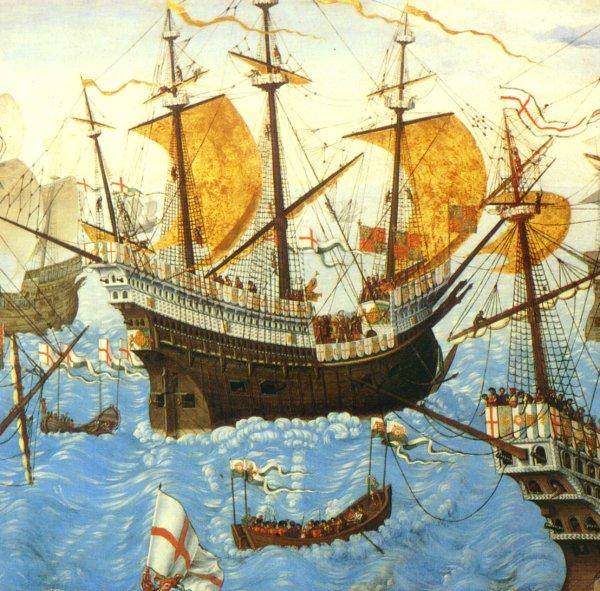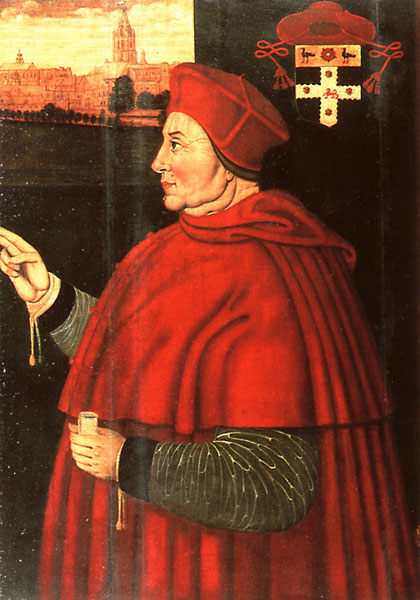Henry VIII
and his Navy
 In Tudor times all warships belonged
to the King or Queen, so they came to be called the Royal Navy.
When Henry VIII became king in 1509, he carried on the work of his father, Henry VII, who had begun to build up the navy. Why was a navy so important to England?For a lot of Henry VIII's reign, England was at war with France. Henry
needed good ships to take his armies to France to attack the French coastline
and shipping. Strong warships could also defend England if an enemy attacked.
This was very important because England is part of an island. Henry also
needed to protect the trading ships carrying cargo to and from England.
In addition to all these reasons, Henry VIII simply loved ships. He loved
to go and watch ships being built, and sometimes held banquets on board.
How did England manage to fight sea battles before the Tudor Kings and Queens began building special fighting ships?If there was going to be any fighting at sea,
other kings had to borrow ships that were usually used for something else,
such as carrying cargo. These are called merchant ships. Henry VIII's father,
Henry VII, began a programme of building warships for a navy, and by the
time he died, and Henry VIII became king, there were 5 royal warships.
Two of them were new four-masted carracks that were much larger than the
usual English merchant ship. By the time that Henry VIII died, in 1547,
the navy had been built up to about 40 ships. Even with this number the
navy still needed to borrow some extra merchant ships to help in battles.
Where were the ships built?The River Thames was far more important for transport
in Tudor times, so it was a good place to put new dockyards for building
ships. The South of England was also a good place to get the materials
for building. All ships were built of wood, which meant that very many
trees were needed, and there were still quite large forests in parts of
Kent and Sussex. Henry VIII started new ship building yards and Deptford
and Woolwich.
1547, Deptford was the most important yard in the country. Both the new yards were very close to Greenwich, where there was a royal palace of which Henry was very fond. He and his daughter Elizabeth were born there, and Henry was married there twice. It was very easy for him to go from Greenwich to visit the new dockyards. As well as space for building the ships, great storehouses also had to be built, because the new ships needed lots of supplies. Henry also set up better systems for organizing the supplies, and running the navy. How did ships change during the time that Henry VIII was king?Warships now carried much heavier cannon on board,
about 20 heavy, and 60 light ones. The great cannon could now fire a 'broadside',
which meant all guns along one side of the ship firing at once. Watertight
'gunports' with hinges were also invented. These gunports were flaps that
covered holes in the side of the ship. The flaps would be opened in a battle
so that the cannon could poke out while they were being fired.
Why were gunports important?The invention of gunports meant that guns could
be carried much lower down in the ship, so that it was much more stable,
and less likely to tip over. The first ship to carry the new guns and fight
in this way was the Mary Rose. The Mary Rose was built in
Portsmouth for Henry VIII between 1509 and 1511, and rebuilt in 1536. She
was Henry's favourite ship and he named her after his sister, Mary. He
was also very proud of the ship called Henry Grace a Dieu, which
was known as the Great Harry.
How big a crew was needed on the new ships?In the 1540s, a warship had a crew that included
about 200 sailors, 185 soldiers, and 30 gunners. Ordinary sailors helped
the gunners with the cannon.
What food did the crew eat?Most of the crew had very plain food to eat. They lived mainly on ships' biscuit (about half a kilogram a day) and dried salted meat, usually pork or beef. Each sailor was also given 10 pints (5.7 litres) of beer every day.What went on during a battle at sea?As well as using the cannon to fire stone and
iron balls at the enemy, Henry's ships would have also carried many archers.
The ship sailed as close as possible to the enemy, and then the archers
tried to shoot arrows at the crew of the opposing ship. The English archers
could fire 10 arrows in a minute. They used longbows while the French archers
used crossbows. Even with the new cannon, they still tried to end a battle
by boarding the enemy's ship. 'Prize money' was given to the sailors if
they managed to capture an enemy ship, so when they fired their cannon,
they were hoping to hit the masts and rigging, not trying to sink the ship.
Giving prize money was also meant to help the captain to get the crew to
obey him in a battle.
What happened to the Mary Rose?On 19th July 1545, while Henry VIII watched, the
Mary
Rose sank very quickly, in the piece of water between Portsmouth and
the Isle of Wight called the Solent. The Mary Rose was part of an
English fleet trying to stop the French ships landing on the Isle of Wight,
but sank before firing a single shot. Around 700 of her crew, including
the captain, Sir George Carew, were drowned, and only about 30 men were
rescued.
Why did the Mary Rose sink?No one is sure exactly why the Mary Rose
capsized. We know that she was very overloaded, carrying 700 rather than
the 400 crew she was built to carry. Once the ship began to tip to one
side, after turning sharply, sea water poured in the gunports. Perhaps
the crew were not obeying orders, for just before the ship went down the
captain shouted that he had the sort of knaves he could not rule.
How do we know so much about the Mary Rose?People living at the time wrote about the Mary
Rose, and drew pictures of her, so we know what she looked like. Almost
as soon as she sank, people tried to lift her, but they could only manage
to raise the masts. She lay on the seabed for over 400 years. Then, in
1967, archaeologists diving in the area where she sank discovered the wreck.
In 1982 she was lifted up from the bottom of the sea.
Lots of things on the ship had been preserved by the mud they were lying in. After more than 400 years at the bottom of the sea, now we can look at them. Most of the things from the Mary Rose are now in a special museum at Portsmouth. This Article © Mary Rose Trust and is used here by permission of Stuart Vine |




